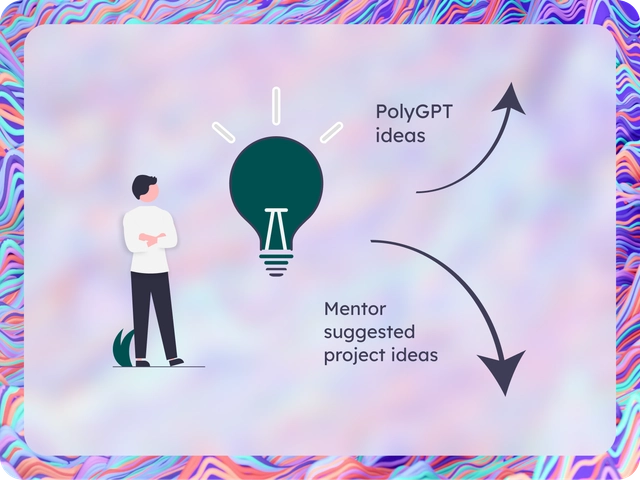Meet PolyGPT, our AI-powered Project Idea Generator
Tell PolyGPT your favorite subject and a few hobbies you're passionate about to generate personalized project ideas.
Log in to explore PolyGPTExplore project ideas with the help of PolyGPT
See your personalized project ideas come to life with PolyGPT! Log in to brainstorm ideas.

We know the jump from your interests to a research project idea can be tricky.
That's why we've built tools to help you find the perfect project idea to lay the foundation of a successful project. Simply copy your favorite idea to your clip board, and paste it in the project idea section of the application.

Browse project ideas by Polygence mentors
Immune Cell Superheroes
What if T cells, B cells, and macrophages were superheroes with special powers? In this project, you’ll learn the basics of the immune system and then turn those ideas into a creative comic, storybook, or animation.
Cancer, Biology

Which Cancer Treatment Wins?
Many cancers have more than one treatment option, like chemotherapy vs. targeted therapy or targeted therapy vs. immunotherapy. In this project, you’ll choose one cancer and compare two different treatment types in terms of how they work, side effects, and outcomes.
Cancer, Biology

Patient-Friendly Guide to Immunotherapy
Lots of patients hear big words like “checkpoint inhibitor” or “CAR T cells” and feel overwhelmed. In this project, you’ll learn the science behind one type of cancer immunotherapy and then create a friendly guide for patients and families.
Cancer, Biology

From Lab Discovery to Patent to Pill Bottle
How does a molecule discovered in a lab eventually become a medicine at the pharmacy? In this project, you’ll pick one drug/therapeutic and trace its journey from scientific discovery, to patents, to clinical trials, to patients. You’ll see how science, law, and business all connect.
Cancer, Biology

Should We Be Allowed to Patent Life? Ethics of Biotech Patents
Can you own a gene? A microbe? A genetically modified plant? In this project, you’ll explore famous court cases and ethical debates around patenting living things. You’ll analyze pro/con arguments and then create your own position statement or policy proposal.
Cancer, Biology

From Idea to IP: Draft a Mock Patent for Your Own Biotech Invention
Have an idea for a new cancer test, microbiome product, or lab gadget? In this project, you’ll design a simple biotech invention and then create a mock patent application for it. We’ll talk about what makes something “patentable” (novel, useful, non-obvious) and translate your idea into basic claims and diagrams.
Cancer, Biology

Dissecting a Biotech Patent: How Scientists Protect Their Ideas
How do scientists legally “claim” an invention so other people can’t copy it? In this project, you’ll pick a real biotech patent (for a cancer drug, diagnostic, or vaccine) and learn how to read it like a scientist–lawyer. We’ll break down the parts of a patent (title, abstract, drawings, claims) and connect each claim to the underlying biology.
Cancer, Biology

How Do LLMs Compare to Classical Machine Learning?
Students explore how different machine learning methods classify text by comparing classical models (TF–IDF + Logistic Regression / Random Forest) with a large language model such as DistilBERT. Using publicly available Amazon review data, the student learns how to clean text, extract features, train models, and compare their performance. They also visualize how models “see” the data using clustering or dimension reduction like PCA or t-SNE.
AI/ML, Statistics

Topological Data Analysis
Did you know data has a "shape" that can be formally analyzed? Instead of just throwing more and more AI at our data issues, we can analyze deeper structures in data using topology. You could help me develop some formal tools and procedures for this type of analysis, and aplly it to your favorite datasets.
Math, Statistics, Physics

Simulating Coherence Times of Qubits
The field of quantum computing is still formulating the best platform for realizing its quantum bits or qubits. Many of these considerations center around the impact of noise, that is stochasticity in the environment which perturb the system. In this project, we would use simulations in Python or Julia to model different qubits and their behavior around different types of noise and see if we can observe any general trends about these relationships. The project would entail various skills and ideas. We would learn what a qubit is and how they are modeled, the process of running and analyzing numerical simulations in Python and/or Julia, the different ways to characterize noise (see pink noise, white noise, brown noise, etc.), and how to find and deconstruct relevant literature. The ultimate goal here would be to write a paper or at least a small note summarizing our findings, potentially with recommendations on how to design more robust qubits given the results we find.
Math, Physics, Quantitative
